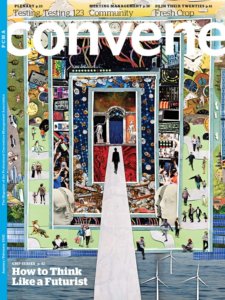
It does seem impossible to predict with complete accuracy what business events in the near and far future will look like, but using a little foresight can help us plan for what’s behind the next door. (Illustration by Ben Lewis Giles)
In a living-with-COVID world, if there was one association that you would assume would know precisely how its upcoming May conference in Toronto will take shape, it would be the Association of Professional Futurists (APF), whose members make their living by helping organizations see what’s around the corner and far down the road. But when Convene spoke in late December with APF board member Joyce Gioia, CEO of The Herman Group of Companies and board liaison for the association’s annual gathering, she said they were still exploring in-person, hybrid, and digital possibilities. (Several weeks after we spoke, Gioia said the decision was made to hold the event virtually.)
The fact that professional futurists couldn’t say for certain what their upcoming event, only five months away, would look like puts the universal challenge of planning in the pandemic’s wake in stark relief. But even setting COVID aside, futurists don’t profess to have a crystal-ball clairvoyant ability to predict the future. They use strategic frameworks and foresight — a mix of intuition, understanding, and imagination, says Switzerland-based futurist Gerd Leonhard — to plan ahead.
The late Alvin Toffler, whose 1970 book Future Shock established him as one of the world’s foremost futurists, said we can only envision our future by tapping into our human capacity for creativity. Maria Bothwell, CEO of Toffler Associates, the strategic advisory firm he founded, shared one of his quotes when she spoke with Convene: “The inability to speak with precision and certainty about the future is no excuse for silence. It’s more important to be imaginative and insightful than to be 100-percent right.”
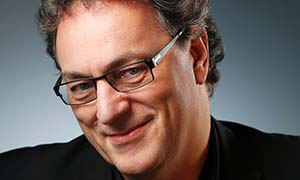 Words From Gerd
Words From Gerd
Switzerland-based futurist Gerd Leonhard is a keynote speaker at global events. He has made a number of his presentations available online at futuristgerd.com. You’ll find some provocative quotes from those videos throughout this story, offered as thought starters.
It does seem impossible to predict with complete accuracy what business events in the near and far future will look like. Will face-to-face event attendance return to 2019 levels soon? Or has there been some fundamental shift? Society’s response to the pandemic is still a work in progress. In Leonhard’s recent keynotes, he underscores what we know only too well: We are experiencing changes that are exponential in nature. Moreover, he says, “the world we’re living in is confusing, paradoxical … and chaotic.” The best we can do, he says, is to pay attention.
Besides using our imagination and keeping our antennae up, what else can we learn from the experts to become, as New York Times bestselling author and technology futurist Daniel Burrus put it, anticipatory rather than reactionary?
Lesson No. 1: Make thinking about the future a regular practice. Burrus recommends we spend one hour a week “unplugging from the present and plugging into our future,” he told Convene. “We’re all going to spend the rest of our lives in the future. Maybe we should think about it a little more often.”
Gioia, publisher of the weekly Herman Trends Alerts, added a sense of urgency to that advice: “Those who do not look to — or prepare for — the future,” she said, “are destined to be its victims.”
We’ve distilled some guiding principles from conversations with futurists Gioia, Bothwell, and Burrus, to help you see, in Leonhard’s words, that “the future is no longer about tomorrow. It’s not a timeframe, it’s a mindset.”

Human creativity is about being able to take a wider view. We can think about what we need to do today to keep business running and we can take a wider view: What do we need to do in five years? Because chances are, it could be entirely different than what we have now.”
Don’t Look Back
One of the things Burrus loves about riding his motorcycle is that it doesn’t go in reverse — in other words, we need to operate in forward mode only. “If you’re really working at trying to go back to the way things were before COVID,” he said, “you’re doing yourself an injustice, regardless of whether you’re a meeting planner or you’re running a hotel or a catering business.”
“The more you’re forcing yourself to think in the future,” Bothwell said, the more you are “opening your sensors. You’re more aware of listening and hearing other things. You start making connections and sense out of things. And that allows you to come back and frame what you might need to do for your particular event in the next year. It helps you not go back to 2019 but create what 2022 or 2025 should be.”
Instead of just tweaking what you used to do, Burrus recommends looking at how to transform your customers’ experience “to an elevated level of relevancy based on the direction the future is going.”
And for event professionals, that means going digital. “As a planner, if you hate virtual,” Burrus said, “it’s kind of like hating change. You’re not going to like the future. Instead of hating it, let’s embrace and extend and transform, meaning what do we do to make meetings a great virtual and physical experience?”
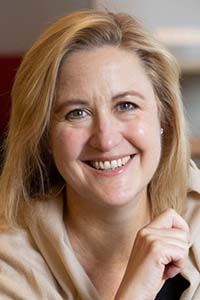
Maria Bothwell
Bothwell acknowledged the “massive challenge” of planning hybrid events to create “two experiences that are equally engaging,” she said. But that’s a prime opportunity to imagine solutions. “Are there new technologies out there that can start bridging the two experiences? There may be,” she said.
Burrus advises planners to seek out tools and systems to make planning hybrid meetings less difficult, time-consuming, and expensive — to explore “how can I actually derive increasing revenue and have the virtual component of a physical meeting be a profit instead of a cost center?”
Gioia is adamant that there is no substitute for face-to-face events. “There is an exchange of energy that takes place. There is a chemistry that happens, a possible collaboration and connection. And these do not happen electronically the way that they happen in person,” she said. “So, I believe that there is going to be a very, very strong desire to get back to being in physical spaces where we can hug each other.” At the same time, another association she belongs to, the Institute of Management Consultants, has held very successful virtual events since COVID and she doesn’t see them going away, even when the pandemic recedes.
Part of our challenge with figuring out what the future will bring, Burrus said, is that it’s “our human default to think about new things with an ‘either/or’ mindset — either it’s going to be live in-person or digital, either it’s going to be paper or digital, either it’s going to be all the vendors on the show floor with their hardware, or it’s all going to be virtual reality.” Burrus attributes much of his ability to forecast with accuracy over nearly four decades to embracing a “both/and” concept.
Here’s how that concept works for events, he said: “The future is definitely in live events — of course, we want to be with other people, we’re human beings. But on the other hand, the virtual element, the hybrid element— oh, that’s there, too. There are certain meetings that would actually serve us well to just be digital — there are things you can do in the digital world that you can’t do in the physical world. There are things you can do in the physical world that you can’t do in the digital world. It’s really important for us to think through what those things are. So, if we are having a physical meeting and we do things that actually could have been done digitally just as well, why do we have the physical meeting? And if we’re in person, we should be maximizing the fact that we’re physically getting together. If you’re smart,” he said, you will embrace both delivery channels. “You’re going to make every meeting a hybrid meeting going forward.”

There are only two reasons why people change: pain and love. We’ve experienced pain as a result of COVID; we’re here to fall in love with new ideas.”
Learn to Find Trendlines
Having foresight requires that you recognize and think through the potential impact of trends. Burrus uses a simple framework for this: Trends are either soft or hard. A hard trend is based on a future fact that will happen — “you can’t stop it,” he said. “A soft trend may or may not happen. And both are very powerful when you’re planning and looking into the future. And then the second element is: What is the opportunity? Because a trend by itself is academic.” The minute you look at the opportunity, Burrus said, “you turn a trend into something that’s actionable.”
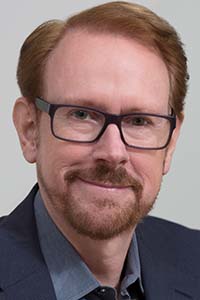
Daniel Burrus
One example of a hard trend having an impact on business and events is that Baby Boomers will continue to retire. Whether they take their knowledge and wisdom with them, Burrus said, is a soft trend, and creates opportunities for organizations, such as developing mentorship programs and “wisdom bases so that they could be sharing their knowledge before they leave.”
Identifying hard trends gives you certainty in an uncertain world, Burrus said, and helps you turn disruption into opportunity. But, he added, “I also love soft trends, because if you don’t like them, you can change them.”
To find the big trends, you must look beyond your immediate sector or profession, and that’s where organizations often fall short in their forecasting and scenario planning, Bothwell said. “If you look at what a futurist does, they’re really trying to look broader at more variables and use what they can see to inform those possible futures,” she said.
Bothwell offers medical associations as an example. Sure, she said, “they care about the future of health care, but they should also be looking at what’s going on in the telecom and data world, what investments or innovations are happening at telecommunications companies, and what investments are being made — and consumer adoptions are taking place — in the finance space, because there’s a big confidential information aspect of finance that will have a ripple effect on consumer behaviors in health care. So, it’s looking at these other sectors that may actually in five to 10 years down the line cause changes in behaviors that are important to be aware of.”
For insights about the future of business events, planners should follow the money in other adjacent areas, like “the shift in revenue for online education at the college level,” Bothwell said, “and shifts in investment in education, advanced certification, online learning and development outside traditional institutions.” Within the industry, look for investments in hotels and conference centers, she said.
Keeping an eye on funding and M&A activity among event technology companies can also be an indication of where the industry is headed.
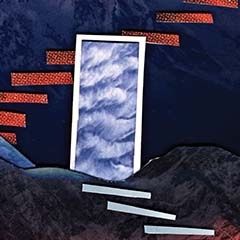
The future of work: If you work like a robot, a robot will take your job. In the good future of work, our ultimate job is to be human.”
Gain Insight From the Future of Work
“The definition of work is going to keep evolving,” Bothwell said. “The whole aspect of how careers are looked at from a continuing-education standpoint, and how organizations are shifting to micro-accreditation or other certifications, or the view of how they fund lifelong learning” will have a direct impact on events, she said, as well as the “loyalty commitment between the employee and the employer with respect to the skills and education of that employee. Is that something that comes back to the employees and they own it, or is that something that’s part of the benefits package and that [employee] contract that’s changing?” Bothwell said the current competitiveness in the talent pool will likely drive some of those changes faster than others, perhaps putting the burden on employers to fund their employees’ continuing education.
How people go back to the office can be instructive in designing multi-channel events. The question that keeps being asked, Burrus said, is whether people “will ever go back to the office again. And my take on that is that we will go back — but remember, we don’t go back to the way things were. We’re going to the office, but not as a place to house all our employees as we did in the past. We’re now looking at how do we maximize having people come to the office to, for example, elevate our ability to collaborate, to innovate, to do what we do best when we’re physically together. And if we aren’t doing that, then we should be working remotely.”
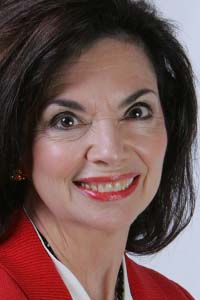
Joyce Gioia
Gioia said HR trends like the Great Resignation affect the business events industry for both internal staffing reasons — “you don’t want to be caught blindsided without the people you need,” she said — and in terms of their attendees. “The Great Resignation is highlighting a shift in values,” she said. “People are reevaluating the jobs that they’re doing based on a lot of different aspects, including the time that they want to spend with their families.” This has a direct impact on an attendee’s willingness to travel to an event.
What’s happening with startups also is something Gioia said planners should have on their radar, because there may be growth opportunities for business events with “new industries and new markets” popping up. “There may not even be an association in that industry yet, but eventually there will be,” she said, “so they need to be watching those trends as well.”
As people quit their jobs and re-evaluate their careers, Gioia sees a potential silver lining for event organizers. Those who leave employers and are therefore no longer funded to attend a conference may be willing to pay their own way for the opportunity to network and learn about a different career path. To Burrus’ point about making trends actionable, this could lead to taking fresh marketing approaches to attract a new audience to an event and putting greater emphasis in the program on networking and career exploration.

Imagining what might be is a gift and it’s also something we can train. Einstein once said imagination is more important than knowledge. We must live in two worlds. On the one hand, we have the facts and knowledge, and on the other hand, we have imagination, storytelling, intuition — that’s what humans do. We exist in engagement, relationships, experiences.”
Be Aware of Developing Technologies
The most predictable hard trend of all, Burrus said, is technology. On the near horizon, he said, are “virtual augmented reality glasses that look like normal glasses” where you can view an overlay of data with a touch of your finger. “What kind of data might I see? Well, I could easily see me moving my finger and being able to see the names of all the people who are sitting in the audience, for example,” he said.
You can’t buy that technology today, Burrus said, “but would you say that will never happen? I think you realize it’s a hard trend, because when it comes to technology, if it can be done, it will be done. And if you don’t do it, someone else will.”
For a trade show where exhibitors bring heavy equipment to the show floor, Burrus imagines a future in which attendees using virtual reality glasses can see and maneuver heavy equipment that is not physically on the show floor. “Does that mean people won’t have to bring anything to demonstrate at convention centers? No, not at all. It means that vendors can show more than they could fit in the physical environment,” he said, demonstrating the “both/and” way of thinking.
Similarly, Bothwell mentioned Apple Glasses, augmented reality smart glasses Apple is working on that is reported to be several years away from market. Event organizers should be keeping an eye on consumer interest in these technologies and on their sales as they become available so that they can think of — and be ready to implement — potential applications. It’s not about predicting whether a particular technology tool will be embraced, it’s “about preparing for these possible futures. In that preparation, you’re understand- ing the risk and opportunities,” she said. Planners need to be thinking about whether there are “new technology investment opportunities to create the future of events,” Bothwell said, like virtual presence, robots, and holograms, and to explore how temporary satellite locations for a metaverse or a recording studio would influence them.
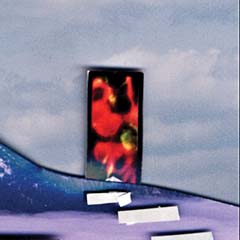
The good future of education is going to be about lifelong learning, on-demand, in all formats and at very low cost.”
Don’t Limit Your Thinking
In their work, Gioia and Bothwell facilitate group exercises that are part of a futurist’s toolkit. Toffler uses an exercise called “Imagine If” (see sidebar of the same name following this story). Gioia employs mind mapping, a form of scenario planning — “investing your team’s time in looking at ‘what if.’ And remember,” she added, “that the more diverse the voices are that you have on your team, the richer your perspectives will be.”
Gioia once facilitated a meeting for women managers and leaders in government in Charlotte, North Carolina, in the early 2000s. “I asked them to mind map wildcards,” she said, meaning no possibility is off the table. “Two of the groups brought up that there could be a banking crisis and Charlotte would lose a lot of its population, because Nations-Bank would be purchased by another bank. Guess what? 2008 rolls around, the Great Recession, and lo and behold, there was a banking crisis. Nations-Bank was absorbed by Bank of America, and exactly what they had mind mapped had come to pass.”
To spur creative thinking, Gioia once had executives looking to re-engineer their major energy company participate in a mind-mapping exercise about moving their headquarters to the moon. It worked, she said, in freeing them up to think about larger possibilities.
It’s about taking it a few steps beyond forecasting. “Forecasting is generally about predicting a future state,” Bothwell said. “We like using a hurricane analogy. When the weather service is forecasting a hurricane to hit land, they give you the cone of likely impact, and then there might be variations off that cone — a 60-percent chance it spreads out, or what have you. That’s forecasting. We would go farther out than that — like, what if it happens way over here, what would that mean? And what if it happens way up there, what would that mean? — without necessarily a probability associated with it. That’s where more of the imagination comes in. We focus on the imagination, not the extrapolation.”
Not putting limits on your imagination could take you to some “horrible or crazy place,” Bothwell said, but “it could be crazy good too. Emphasize the plausible, not the probable. So again, it’s not about the probability of X happening. It’s more like, could this happen? Is it possible? If it is, we should be thinking about it. The whole reason to focus on that is not to constrain your thinking because out of that, ideas are going to flow.”
You also need to be intentional about thinking in the extreme versus being balanced, Bothwell said. “We often do that where we’ll look at two to four extreme cases to really force ourselves out of the rationalization of reality, so you’re really thinking about the risk. What are the concerns, what are the opportunities there? And then we can work that back in a planning model that may get more into probabilities or a reality.”
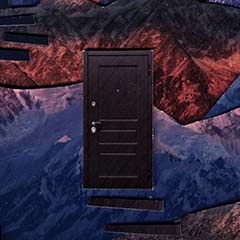
We have to define: What is a good future? There are three tickets to the good future: digitization; total decarbonization — getting out of the fossil fuel industry — this is the biggest thing; and reformation — we are going to have to rethink what kind of logic do we want. If we have system collapse because of the environment or social unrest, you can make as much money as you want, it won’t matter unless you can go to Mars.”
Be Bold
If all you see coming out of the pandemic is crisis, Burrus said, “I’m afraid you’re not going to see the opportunity. There have never been more opportunities for event planners to redefine their customer experience than there are today.”
Bothwell also takes a blue-sky view. “I would say that this is a time to be creative and imaginative,” Bothwell said, “to have a test-and-learn mentality. Everybody’s norm was tossed up in the air — so seize that as an opportunity to try to do things differently and advance the art of planning an event.”
“The need for meaningful and transformational events and meetings will only increase as the pace of change accelerates,” Burrus said.“I’m calling that a hard trend. We don’t need the old version of you. We need the new version of you. What if we could make the future better than our best past?”
Michelle Russell is editor in chief of Convene.
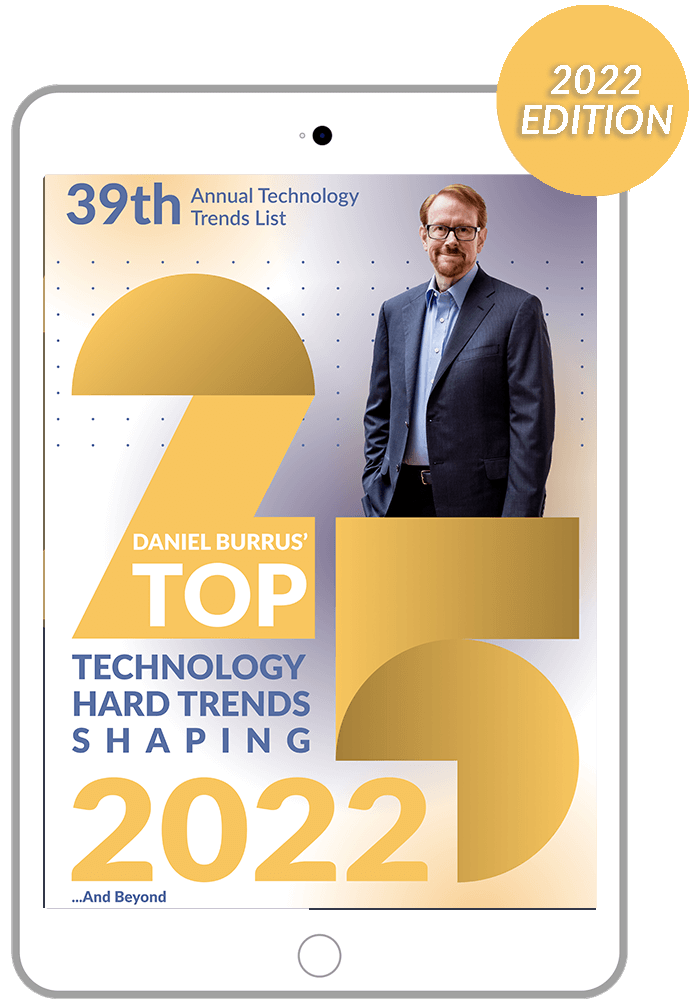
To download a copy of Daniel Burrus’ “25 Technology Hard Trends Shaping 2022 and Beyond,” visit burrus.com/seethefuture.

Imagine If
Toffler Associates uses a tool called “Imagine If” as part of its foresight process to help organizations “understand, prepare for, and even influence the future.”
The exercise starts with a single premise about the future, which is used to identify second- and third-order impacts of the original premise. For example, what could be the follow-on effects of autonomous vehicles as the dominant form of transportation? After identifying a few obvious direct impacts, real insights evolve as participants continue to stretch their imagination throughout the exercise.
One direct impact could be fewer auto accidents. Continuing down that path, there may be fewer hospital emergency room visits, a reduced demand for personal injury attorneys, and even increased incentives for developing new organ transplant sources.
Asking “if this happens, then what could happen next?” supports the futures and foresight process by showing how one key change is a catalyst for wide range of opportunities and challenges for an organization.
Excerpted from Toffler Associates’ paper, “The Problem With Traditional Strategic Planning,” available for download at tofflerassociates.com.
Short-Term Planning Signals
As planners try to estimate their stakeholders’ appetite to attend their face-to-face events in 2022, they would do well to “remember that attendees are consumers,” Toffler Associates’ Maria Bothwell said. “They may be an employee of an organization that’s your target [audience], but they’re also consumers.” She recommends paying attention to changing consumer expectations around “what does it mean to be in a safe environment?” It’s critical that event hosts communicate and provide a sense of safety and security, not only “from a health standpoint,” she said, “but a data security and physical security standpoint as well.”
One telling consumer signal to keep an eye on, according to The Herman Group of Companies’ Joyce Gioia, is “people’s attitudes toward going out. Look at what’s happening in the restaurant industry. If people aren’t willing to go out to dinner and movies and sit in restaurants and theaters, then they’re certainly not going to want to attend conferences. Those can be good reflections of what’s going on in the hearts and minds of potential and registered attendees.”
Similarly, Bothwell recommends checking out airline ticket prices and rental car reservation rates and availability as they also can be indicators of consumer and employer comfort in travel.
‘A New Appreciation’
Convene asked Maria Bothwell how Toffler Associates’ clientele has changed during the pandemic. Here’s her response:
“There is a new appreciation for looking beyond the next capital budget cycle of one to three years, which is great. And for the most part, I would say our clients are less focused on risk and resilience now. It’s been more about innovation and not being caught by surprise — what are those opportunities so that the next time something big happens, we’re prepared and we can start making investments now that poise us to be in a much better position for growth in the future. It’s more about growth than risk. Early on in the pandemic, conversations were much more focused on risk and preparation. Now, because there’s much more capital available, it’s more about growth and investment opportunity and what could be on the horizon that they don’t want to miss.”
Earn CMP Credits
Earn one clock hour of certification by visiting Convene CMP Series page to answer questions about the article above and the Harvard Business Review article, “Six Rules for Effective Forecasting,” by Paul Saffo at hbr.org.
The Certified Meeting Professional (CMP) is a registered trademark of the Events Industry Council.

